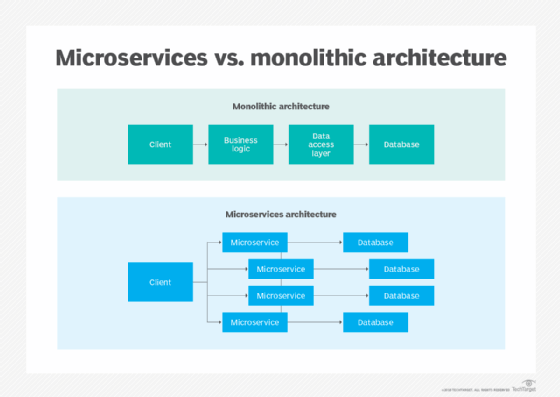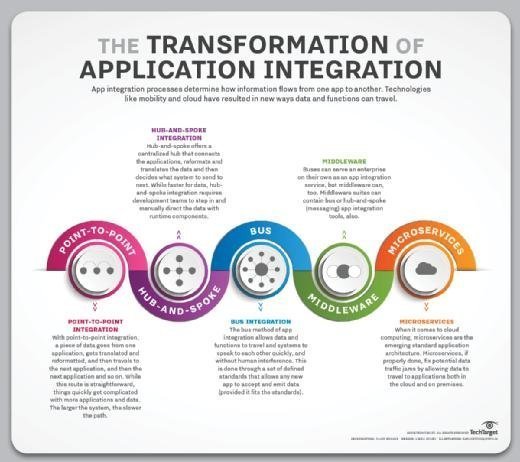EAI (enterprise application integration)
What is EAI?
Enterprise application integration (EAI) is the task of uniting the databases and workflows associated with business applications to ensure that the business uses the information consistently and that changes to core business data made by one application are correctly reflected in others.
Why is enterprise application integration important?
Most businesses use several software products from different vendors in their day-to-day operations. These applications can have different uses, data stores and methods of operation. This can create data silos where data is either duplicated between databases or is available in one but not another. That leads to data inconsistency when users need to manually copy and paste data between applications. Users may also need to consult several applications for their daily work.
EAI provides a methodology that helps these disparate applications share data and workflows to reduce manual steps and errors and to provide better insight into organizational data. This becomes more important as an organization grows and as technology advances.
In the past, all business workflows were manual and carried out on paper. As computers automated work for users, the day-to-day assignments of information workers quickly became formatting data and transferring it from one system to another. This need to quickly make data available between applications will only increase as more organizations adopt microservices, software as a service (SaaS) and platform as a service (PaaS) tools.
EAI can help to remove manual steps and reduce user error.

How does enterprise application integration work?
EAI is a principal or philosophy toward the programs in use at a business. It is not a specific tool or framework. It's best thought of as a goal or ideal to reach toward rather than an implementation.
Organizations can be at different levels of EAI, from applications existing separately to full integration where all applications share common data and workflows. More realistically, most will fall somewhere in between, with some applications working together and other not. Businesses are always changing, so any EAI implementation must also be able to change.
EAI does not require that someone reprograms the applications themselves. Instead, organizations typically use middleware or APIs to get applications to work together. EAI also makes it easier to swap applications to suit business needs without impacting productivity or requiring large-scale system designs.
Not cloud or on-premises specific, a well-done EAI implementation can account for applications with different sources and underlying infrastructure needs. EAI attempts to solve the same business issues as using a single enterprise resource planning (ERP) package, but with several smaller programs working together instead of one large program.
Almost all organizations use some form of EAI. Taking the output of one program and running a Microsoft Excel macro or a script to reformat it to enter into another program can be thought of as a simple form of EAI.
Goals of enterprise application integration
Database integration is a common and relatively easy goal for EAI. Removing duplication of data and ensuring consistency between applications can reduce mistakes and liability. EAI can be achieved by setting different applications to use the same database or using synchronization tools to keep different databases up to date with changes. Data warehouse designs can make this possible. All these can also be more easily fed into big data systems for better business intelligence (BI).
Workflow integration can get separate tools to work together to increase productivity by making common tasks easier to accomplish. As an example of EAI, onboarding an employee may require human resources to update payroll, personnel records, desk assignments on a floor plan, door access controls and IT resources. With EAI, all these different tasks can be accomplished as a single workflow instead of in separate programs.
Interface integration allows organizations to present a single consistent user interface and user experience (UI and UX) to operators instead of multiple interfaces from different software packages. This can be the most difficult form of EAI to achieve as minor changes to the underlying software can result in redesign work.

Types of enterprise application integration
An EAI implementation depends on the underlying project tools and goals, but several common design paradigms have emerged.
Point-to-point integration. This is the simplest form of EAI. In it, data is taken from one source, perhaps reformatted, and then ingested by the next application. These are often simple to implement for small workflows and a few tools. They can quickly grow large and difficult to manage as more applications and integrations are added, however, and can become slow as a backlog or slowdown in one system affects others in the line.
Hub-and-spoke integration. This approach uses a central program to facilitate the data and steps between the participation applications. The program can handle the data reformatting and keep workflows moving in the event of an application slowdown. Hub-and-spoke is therefore faster and more reliable than point-to-point but requires development time and effort to set up and maintain.
Bus integration. This is an evolution of hub-and-spoke design EAI. It is also called an enterprise service bus (ESB). In a common bus design, all participating applications use a set of standards to send and receive data or workflows. This allows for quick and easy integration but requires work during the planning and product selection phase.
Middleware integration. This involves an intermediary program that sits between the end user and the underlying application. Middleware supports interface integration and may have an underlying hub-and-spoke or bus design.
Microservices. These are small, single-purpose tools that support EAI initiatives. These can be serverless functions or dedicated apps designed to integrate easily or quickly connect programs. Microservices can often be easily offloaded as cloud workloads.
Explore 3 top integration frameworks and what an automated data integration implementation means.







